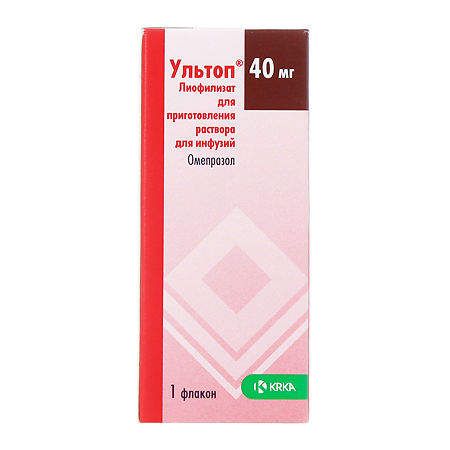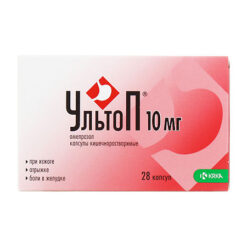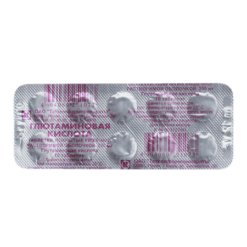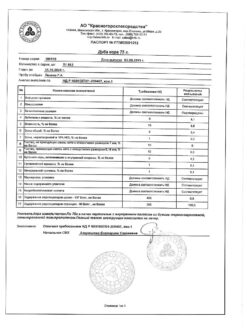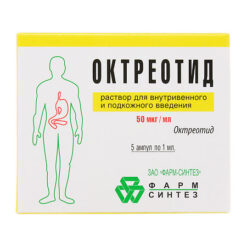No products in the cart.
Ultop lyophilizate 40 mg
€1.00
Out of stock
(E-mail when Stock is available)
EAN: 3838989530303
SKU: 212465
Categories: Medicine, Stomach, intestines, liver, Ulcer and gastritis
Description
Pharmacodynamics
Inhibits the enzyme H+ K+ ATPase (“proton pump”) in the parietal cells of the stomach and thus blocks the final stage of hydrochloric acid synthesis.
This leads to a decrease of basal and stimulated secretion, regardless of the nature of the stimulus. After a single administration of the drug, the pharmacological effect lasts for 24 hours.
Pharmacokinetics
The binding to plasma proteins is 95%. Omeprazole is almost completely metabolized in the liver. It is an inhibitor of the CYP2C19 enzyme system. The elimination half-life after intravenous administration is 40 minutes and does not change with long-term treatment. Excretion by the kidneys (70-80%) and with the bile (20-30%).
In chronic renal insufficiency, excretion decreases in proportion to the decrease in creatinine clearance.
Indications
Indications
Active ingredient
Active ingredient
Composition
Composition
1 vial contains:
the active ingredient:
omeprazole 40.00 mg
excipients:
1N sodium hydroxide solution -0.132 ml,
dinatrium edetate-1 mg.
How to take, the dosage
How to take, the dosage
In patients with gastric and duodenal ulcer or reflux esophagitis, intravenous administration of Ultop at a dose of 40 mg once daily is recommended if oral therapy is not possible. In patients with Zollinger-Ellison syndrome, an initial intravenous injection of Ultop at a dose of 60 mg per day is recommended. Doses are adjusted individually, sometimes a higher dose is required. If the daily dose is greater than 60 mg, the dose should be divided into two injections.
The infusion solution of Ultop is administered intravenously by drip for 20-30 minutes. It is recommended to administer the infusion solution immediately after its preparation.
Patients with impaired renal function – no dose adjustment is necessary.
Patients with impaired hepatic function – the half-life of omeprazole is longer, reduction of the daily dose to 10-20 mg is recommended.
Patients of advanced age do not require dose adjustments.
Preparation of Ultop infusion solution.
The lyophilized powder of omeprazole is dissolved in 100 ml of 5% dextrose (glucose) infusion solution or in 100 ml of physiological infusion solution. Infusion solution on 5% dextrose should be used within 6 hours. The infusion solution on physiological solution should be used within 12 hours.
Interaction
Interaction
Interactions of omeprazole with other medicinal products are rare. There is a possibility of interaction with drugs that are metabolized in the liver with participation of cytochrome P450 enzyme. Plasma concentrations of diazepam, phenytoin, nifedipine, warfarin, aminopyrine, antipyrine and disulfiram may increase. Generally, this increase is clinically insignificant for conventional doses of omeprazole. However, it is recommended that patients be monitored when starting or cancelling treatment with Ultop and that doses of phenytoin, diazepam, warfarin, and disulfiram be adjusted if necessary.
Concomitant administration of clarithromycin increases serum concentrations of clarithromycin and omeprazole.
Increased gastric pH may decrease bioavailability of ampicillin, ketoconazole, itraconazole and iron drugs.
The simultaneous administration of omeprazole and digoxin in healthy people increases the bioavailability of digoxin by 10% due to increased gastric pH.
The efficacy of prednisolone and cyclosporine may be reduced. Therefore, sometimes it is necessary to adjust the dose of cyclosporine.
No clinically significant interaction has been found with concomitant administration of antacids, amoxicillin, digoxin, theophylline, lidocaine, quinidine, metoprolol or propranololol.
Special Instructions
Special Instructions
Before starting therapy, it is important to rule out the presence of a malignancy (especially with gastric ulcers), because treatment, by masking symptoms, can delay a correct diagnosis.
In elderly patients, no dose adjustment is necessary. The bioavailability of omeprazole is increased in patients with cirrhosis, but no increase in toxicity has been noted. The daily dose should not exceed 20 mg.
No dose adjustment is required for patients with renal disease. Dialysis in patients with chronic kidney disease has no effect on the pharmacokinetic properties of omeprazole.
Impact on ability to drive and other mechanisms
In usual doses, the drug has no effect on the speed of psychomotor reactions and concentration.
Contraindications
Contraindications
With caution: renal and/or hepatic failure, hereditary fructose intolerance, glucose and/or galactose malabsorption syndrome, or sucrose/isomaltose deficiency.
Side effects
Side effects
Digestive system disorders: diarrhea or constipation, nausea, vomiting, flatulence, abdominal pain, dry mouth, taste disorders, stomatitis, transient increase in the activity of “liver” enzymes in plasma; in patients with previous severe liver disease – hepatitis (including jaundice), liver function impairment.
Nervous system disorders: headache, dizziness, agitation, drowsiness, insomnia, paresthesia, depression, hallucinations; in patients with severe concomitant somatic diseases, patients with previous severe liver disease – encephalopathy.
Musculoskeletal system disorders: muscle weakness, myalgia, arthralgia.
Hematopoietic system disorders: leukopenia, thrombocytopenia; in some cases – agranulocytosis, pancytopenia.
The skin: itching, skin rash; in some cases – photosensitization, erythema multiforme, alopecia.
Allergic reactions: urticaria, angioneurotic edema, bronchospasm, interstitial nephritis, anaphylactic shock, fever.
Others: visual disturbance, peripheral edema, increased sweating, gynecomastia; rarely – formation of gastric glandular cysts during long-term treatment (consequence of inhibition of hydrochloric acid secretion, is benign, reversible).
If Ultop is used for a short period of time, side effects are rare and mild and transient. Most often, side effects occur at the beginning of treatment. During prolonged treatment, the frequency of side effects decreases.
Serious side effects are very rare. If they develop, treatment should be discontinued. The incidence of side effects in patients older than 65 years is the same as in younger patients.
Overdose
Overdose
Symptoms: abdominal pain, drowsiness, headache, dizziness, dry mouth, tachycardia, arrhythmia, blurred vision, agitation, confusion, increased sweating, nausea; in rare cases; seizures, shortness of breath, hypothermia.
Treatment is symptomatic. There is no specific antidote. Hemodialysis is ineffective.
Pregnancy use
Pregnancy use
Safety of use during pregnancy and lactation has not been studied. Therefore, it is not recommended to prescribe the drug during pregnancy.
Breastfeeding should be stopped if it is necessary to prescribe the drug during lactation.
Similarities
Similarities
Additional information
| Shelf life | 2 years. |
|---|---|
| Conditions of storage | Store at a temperature not exceeding 25 ° C, in a light-protected place. . |
| Manufacturer | KRKA dd Novo mesto, Slovenia |
| Medication form | solution for infusion |
| Brand | KRKA dd Novo mesto |
Other forms…
Related products
Buy Ultop lyophilizate 40 mg with delivery to USA, UK, Europe and over 120 other countries.

